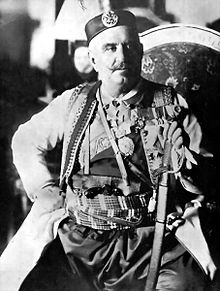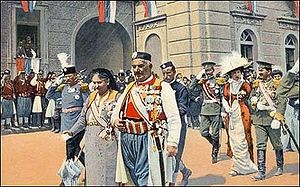- Nicholas I of Montenegro
-
Nicholas I 
King Nikola (Nicholas) I Prince of Montenegro Reign 13 August 1860 - 28 August 1910 Predecessor Danilo I King of Montenegro Reign 28 August 1910 - 26 November 1918 Coronation 28 August 1910[citation needed] Spouse Milena Vukotić Issue Zorka, Princess of Serbia
Milica, Grand Duchess of Russia
Anastasia, Grand Duchess of Russia
Danilo, Crown Prince of Montenegro
Elena, Queen of Italy
Anna, Princess Francis Joseph of Battenberg
Prince Mirko
Princess Xenia of Montenegro
Prince PeterFull name Nikola Mirkov Petrović-Njegoš Royal house House of Petrović-Njegoš Father Mirko Petrović-Njegoš Mother Anastasija Martinović Born 7 October 1841
Njeguši, MontenegroDied 1 March 1921 (aged 79)
Cap d'Antibes, FranceBurial Cetinje, the Chapel of Cipur[citation needed] Signature Religion Orthodox Christian Nikola I Mirkov Petrović-Njegoš (Serbian Cyrillic: Никола I Мирков Петровић-Његош) (October 7 [O.S. September 25] 1841 – March 1, 1921) was the only king of Montenegro, reigning as king from 1910 to 1918 and as prince from 1860 to 1910. He was also a poet, notably penning "Onamo, 'namo!", a popular song from Montenegro.
Contents
Early life
Nikola was born in the village of Njeguši, the ancient home of the reigning House of Petrović. His father, Mirko Petrović-Njegoš, a celebrated Montenegrin warrior, was elder brother to Danilo II of Montenegro, who left no male offspring. After 1696, when the dignity of Vladika, or prince-bishop, became hereditary in the Petrović family, the sovereign power had descended from uncle to nephew, the Vladikas belonging to the order of the black clergy (i.e., monastic clergy) who are forbidden to marry. A change was introduced by Danilo II, who declined the episcopal office, married and declared the principality hereditary in the direct male line. Mirko Petrović-Njegoš having resigned his claim to the throne, his son was nominated heir, and the old system of succession was thus accidentally continued.
Prince Nikola, who had been trained from infancy in martial and athletic exercises, spent a portion of his early boyhood at Trieste in the household of the Kustic family, to which his aunt, the princess Darinka, wife of Danilo II, belonged. The princess was an ardent francophile, and at her suggestion the young heir of the viadikas was sent to the Lycée Louis-le-Grand in Paris. Unlike his contemporary, King Milan of Serbia, Prince Nikola was little influenced in his tastes and habits by his Parisian education; the young highlander, whose keen patriotism, capability for leadership and poetic talents early displayed themselves, showed no inclination for the pleasures of the French capital, and eagerly looked forward to returning to his native land.
Prince of Montenegro
He was still in Paris when, in consequence of the assassination of his uncle Danilo II, he succeeded as prince (August 13, 1860). In November 1860 he married Milena, daughter of the vojvoda Petar Vukotić.
In the period of peace which followed he carried out a series of military, administrative and educational reforms. The country was embroiled in a series of wars with the Ottoman Empire between 1862 and 1878. In 1867 he met the emperor Napoleon III at Paris, and in 1868 he undertook a journey to Russia, where he received an affectionate welcome from the tsar, Alexander II. He afterwards visited the courts of Berlin and Vienna. His efforts to enlist the sympathies of the Russian imperial family were productive of important results for Montenegro; considerable subventions were granted by the tsar and tsaritsa for educational and other purposes, and supplies of arms and ammunition were sent to Cetinje. In 1871 Prince Dolgorukov arrived at Montenegro on a special mission from the tsar, and distributed large sums of money among the people. In 1869 Prince Nikola, whose authority was now firmly established, succeeded in preventing the impetuous highlanders from aiding the Krivosians in their revolt against the Austrian government; similarly in 1897 he checked the martial excitement caused by the outbreak of the Greco-Turkish War.
Follow me Montenegrins - on to Bar, on to our Serb Bar, on to Serb sea!...[1]
In 1876 he declared war against Turkey; his military reputation was enhanced by the ensuing campaign, and still more by that of 1877/78, during which he captured Nikšić, Bar and Ulcinj. The war resulted in a considerable extension of the Montenegrin frontier and the acquisition of a seaboard on the Adriatic. He justified the war as a revenge for the Battle of Kosovo in 1389. In 1876 he sent a message to the Montenegrins in Herzegovina:
- Under Murad I the Serbian Tsardom was destroyed, under Murad V it has to rise again. This is my wish and wish of all of us as well as the wish of almighty God.
The independence of Montenegro was recognised at the Congress of Berlin in 1878 and in the succeeding decades Montenegro enjoyed considerable prosperity and stability. Education, communications and the army expanded greatly (the latter with support from Imperial Russia). In 1883 Prince Nikola visited the sultan, with whom he subsequently maintained the most cordial relations; in 1896 he celebrated the bicentenary of the Petrović dynasty, and in the same year he attended the coronation of the Tsar Nicholas II; in May 1898 he visited Queen Victoria at Windsor Castle.
King of Montenegro
In 1900 he took the style of Royal Highness. He gave Montenegro its first constitution in 1905 following pressure from a population eager for more freedom. He also introduced west-European style press freedom and criminal law codes. In 1906, he introduced Montenegrin currency, the perper. On the August 28, 1910, during the celebration of his jubilee, he assumed the title of king, in accordance with a petition from the Skupština. He was at the same time gazetted field-marshal in the Russian army, an honor never previously conferred on any foreigner except the Duke of Wellington. When the Balkan Wars broke out in 1912 King Nicholas was one of the most enthusiastic of the allies. He wanted to drive the Ottomans completely out of Europe. He defied the Powers and captured Scutari despite the fact that they blockaded the whole coast of Montenegro. Again in the Great War which began in 1914 he was the first to go to Serbia's aid to repel the Austrian forces from the Balkan Peninsula. He was personally a huge supporter of Serbdom, and wished for Serb unity. However, he was bitterly opposed to the Karađorđevićs.
After the First World War Montenegro united with the other south Slav lands, to form the Kingdom of Serbs, Croats and Slovenes, which was renamed Yugoslavia in 1929. Nikola went into exile in France 1918, but continued to claim the throne until his death in Antibes three years later. He was buried in Italy. In 1989, the remains of Nikola, his queen Milena, and two of their twelve children were re-buried in Montenegro.
Children
House of Petrović-Njegoš Nicholas I Children Princess Zorka Princess Milica Princess Anastasia Princess Marica Crown Prince Danilo Princess Elena Princess Ana Princess Sofia Prince Mirko Princess Xenia Princess Vera Prince Peter Grandchildren Prince Stephan Prince Stanislav Prince Michael Prince Paul Prince Emanuel Great Grandchildren Prince Nicholas Great Great Grandchildren Princess Altinaï Prince Boris Great Great Great Grandchildren Princess Milena Five of his daughters were married, each to princes and kings, giving Nikola the nickname "the father-in-law of Europe", a sobriquet he shared with the contemporary King of Denmark.
- Princess Ljubica, known as Zorka (Cetinje, Montenegro, December 23, 1864 - Cetinje, March 28, 1890) married Petar Karađorđević (who after her death would become King Peter I, King of the Serbs, Croats, and Slovenes, which became Yugoslavia, annexing Montenegro from Nikola himself);
- Princess Milica (Cetinje, Montenegro, July 26, 1866 - Alexandria, Egypt, September 5, 1951) was married to Grand Duke Peter Nicolaievich Romanov of Russia, brother of Grand Duke Nicholas Nicolaevich;
- Princess Anastasija (Cetinje, Montenegro, January 4, 1868 - Antibes, France, November 15, 1935) (also known as Princess Stana) was married first with George, Duke of Leuchtenberg and after divorce secondly to the World War I general Grand Duke Nicholas Nicolaevich of Russia, the younger; both her husbands were grandsons of Emperor Nicholas I and she had two children by her first marriage;
- Princess Marica (Cetinje, Montenegro, March 29, 1869 - St. Petersburg, Russia, May 7, 1885);
- Crown Prince Danilo Aleksandar (Cetinje, Montenegro, June 29, 1871 - Vienna, Austria, September 24, 1939) married Duchess Jutta (later known as Militza) of Mecklenburg-Strelitz, they had no children;
- Princess Jelena (Cetinje, Montenegro, January 8, 1873 - Montpellier, France, November 28, 1952) became Queen Elena of Italy, wife of Victor Emmanuel III of Italy;
- Princess Ana (Cetinje, Montenegro, August 18, 1874 - Montreux, Switzerland, April 22, 1971), married Prince Franz Joseph of Battenberg, but remained childless;
- Princess Sofiya (Cetinje, Montenegro, May 2, 1876 - Cetinje, June 14, 1876);
- Prince Mirko Dimitri (Cetinje, Montenegro, April 17, 1879 - Vienna, Austria, March 2, 1918) married Natalija Konstantinović, a cousin of Alexander I Obrenović, and had a son, Prince Michael of Montenegro;
- Princess Kseniya (Cetinje, Montenegro, April 22, 1881 - Paris, France, March 10, 1960);
- Princess Vjera (Rijeka, Croatia, February 22, 1887 - Antibes, France, October 31, 1927);
- Prince Petar of Montenegro (Cetinje, Montenegro, October 10, 1889 - Meran, Italy, May 7, 1932); married 1924 Violet Wegner (after conversion to Orthodoxy her name was Ljubica). They had no children.
The present heir to the throne is King Nikolas's great-grandson Prince Nikola, Prince Michael's son.
References
External links
- The national Museum of Montenegro
- Burial places of Montenegrin rulers
- Digital Library of Montenegrin Culture - in Montenegrin
- The Njegoskij Fund Public Project : Private family archives-based digital documentary fund focused on history and culture of Royal Montenegro.
- Crnogorska kraljevska loza
- Video footage of king Nicholas on Youtube (in Croatian)
 This article incorporates text from a publication now in the public domain: Chisholm, Hugh, ed (1911). Encyclopædia Britannica (11th ed.). Cambridge University Press.
This article incorporates text from a publication now in the public domain: Chisholm, Hugh, ed (1911). Encyclopædia Britannica (11th ed.). Cambridge University Press.
Nicholas I of MontenegroBorn: October 7 1841 Died: March 1 1921Regnal titles Preceded by
Danilo IIPrince of Montenegro
1860 – August 28, 1910Proclaimed King of Montenegro New title King of Montenegro
August 28, 1910 – November 26, 1918Title abolished
Vacant Montenegrin monarchy not restored yetPolitical offices Preceded by
Danilo II
as Prince of MontenegroHead of State of Montenegro
as Prince of Montenegro, later as King of Montenegro
1860 – November 26, 1918Succeeded by
Petar I
as King of YugoslaviaTitles in pretence Loss of title — TITULAR —
King of Montenegro
November 26, 1918 – March 1, 1921Succeeded by
Crown Prince Danilo1918-1921 King Nicholas I
1921 1921-1986 1986-present Categories:- Rulers of Montenegro
- House of Petrovic-Njegoš
- Montenegrin people
- Montenegrin nobility
- Serbian Orthodox Christians
- Serbs of Montenegro
- Serbian poets
- Serbian soldiers
- Orthodox monarchs
- Pretenders to the Montenegrin throne
- Honorary Knights Grand Cross of the Royal Victorian Order
- Lycée Louis-le-Grand alumni
- Field Marshals of Russia
- People of the Russo-Turkish War (1877–1878)
- Recipients of the Order of Saint George II Class
- Recipients of the Order of Saint George III Class
- Knights of the Order of the Most Holy Annunciation
- 1841 births
- 1921 deaths
Wikimedia Foundation. 2010.



